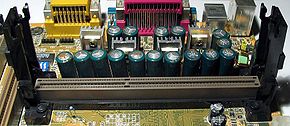Slot A
 | |
| Type | SECC |
|---|---|
| Chip form factors | PGA |
| Contacts | 242 |
| FSB protocol | EV6 |
| FSB frequency | 200 MT/s, 266 MT/s |
| Voltage range | 1.3 - 2.05 V |
| Processors | AMD Athlon (500-1000 MHz) |
This article is part of the CPU socket series | |
Slot A refers to the physical and electrical specification for a 242-lead single-edge-connector used by early versions of AMD's Athlon processor.[1]
The Slot A connector allows for a higher bus rate than Socket 7 or Super Socket 7. Slot A motherboards use the EV6 bus protocol, a technology originally developed by Digital Equipment Corporation (DEC) for its Alpha 21264 microprocessor.
Slot A is mechanically compatible but electrically incompatible with Intel's Slot 1. As a consequence, Slot A motherboards were designed to have the connector's installed orientation be rotated 180 degrees relative to Slot 1 motherboards to discourage accidental insertion of a Slot 1 processor into a Slot A motherboard, and vice versa. The choice to use the same mechanical connector as the Intel Slot 1 also allowed motherboard manufacturers to keep costs down by stocking the same part for both Slot 1 and Slot A assemblies.
Slot A was superseded by Socket A.
See also
References
This article is based on material taken from the Free On-line Dictionary of Computing prior to 1 November 2008 and incorporated under the "relicensing" terms of the GFDL, version 1.3 or later.
- ^ "CPU Sockets Chart". users.erols.com. Retrieved 2009-04-04.
